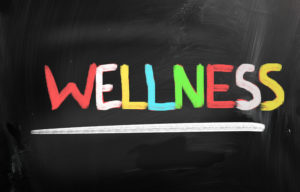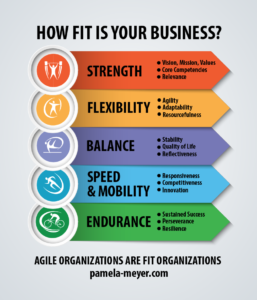How Fit is Your Business?
Halloween, Thanksgiving, Holiday Parties, oh my! The fall and winter months are truly an  indulgent time of year.
indulgent time of year.
Really it’s no wonder that by New Year’s Eve “getting fit” is often the first thing on our minds!
As a result, many of us, make time to check in on personal health and well-being. I’ve found that it’s effective to ask similar questions about our businesses and organizations. You likely have a vision, a mission, and proven values but is your organization truly fit for the year ahead?
Health and Fitness is the Key
The World Health Organization defines health as “a state of complete physical, mental and social well-being, and not merely the absence of disease” (2006). Fitness is variously characterized as a healthy balance of strength, flexibility, balance (at least for most athletes), speed and/or mobility, and endurance. It turns out, these same characteristics lead to fit organizations!
Many day-to-day business responsibilities and operations are routine, but in order to be prepared for the unexpected and unplanned, we must constantly scan the environment for new opportunities and challenges.
Keeping Your Business “Fit” Will Keep
Your Moves Agile!
Get Well. Stay Well.
The connection between individual and organizational health is more than a metaphor. All you  need to do is think of a time when you let your own health and well-being practices slip. Perhaps you were in a stressful period of work, or recent travels disrupted your exercise routine and healthy eating habits.
need to do is think of a time when you let your own health and well-being practices slip. Perhaps you were in a stressful period of work, or recent travels disrupted your exercise routine and healthy eating habits.
While we might be able to ride out such a disruption for a short time, we all know that longer stretches can create bad habits and take a toll. In the long term, attending to our health and fitness prevents illness, injury, and maintains mental and emotional health.
In other words, we might be able to maintain our performance over a short stretch—to meet a project deadline, respond to a crisis, or get through a significant disruption—but our capacity to perform long-term demands requires constant attention to our organizational fitness, just as does our personal health and fitness does.
The Common Denominator is Performance!

Over the next few weeks I will share more about how these five key indicators describe athletic, as well as workplace success and how, as we kick off a new year with positive intentions and new possibilities, you can attend to both. In previous posts, I refer to these as intentional practices.
From Personal Fitness to Organizational Fitness
In the graphic above I introduce a few ways each of the dimensions of physical fitness extend to organizational fitness.
Each of the fitness indicators are interrelated. If you have ever witnessed someone spend all of their time in the weight lifting section of the gym, you know what I mean. This is actually where the term muscle-bound comes from.
Focusing only on strength can literally bind your joints and your ability to have a full range of motion. Consequently, strength and flexibility enhance each other. Stretching the muscles actually allows for access to the power of the whole length of the muscle fiber. Shorter muscles, mean less strength and a smaller range of motion. While only focusing on flexibility without strength can lead to a total lack of stability.
Translate this to the capacity of individual leaders, teams and even entire organizations and the same is true. Only focusing on one or two core competencies without continuously staying relevant to the changing needs and opportunities in the market limits your ultimate competitive strength. At the same time, being overly responsive to changes in the market without attention to  your core strengths can quickly lead to organizational instability.
your core strengths can quickly lead to organizational instability.
In the coming weeks, I will take a closer look at each of these dimensions of fitness and link them to more Make Shift Happen practices to help you improve your organizational fitness and reach your business goals.
Let’s Make Shift Happen in 2018!
